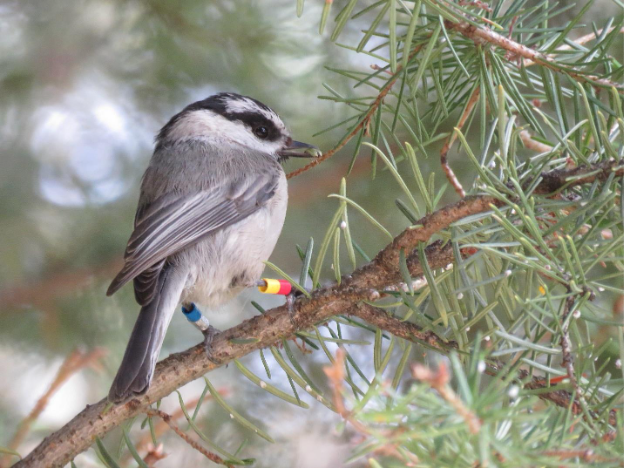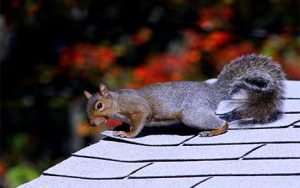In this blog post, Tim Forrester helps answer a weighty question: Does weight loss help or hurt nesting birds? Based on his recent paper with Tom Martin, “Observational and experimental evidence that rapid mass loss is consistent with the flight efficiency hypothesis and not caused by reproductive effort in three passerine bird species”, Tim shares the fascinating physiological adaptations undergone by songbirds in anticipation of the hard work it takes to raise hatchlings. Peek behind the paper to understand the efforts songbirds go through to ensure their young are well looked after, with a reminder to maintain that curiosity to observe the natural world and persevere (even during a pandemic!).
About the Paper
The large investment of time and energy that it takes to raise young is a struggle that both humans and animals understand. Biologists have long been interested in the strategies that organisms use to overcome that struggle and to maximize their reproductive success, as well as the costs that reproduction imposes. Ornithologists long ago noted that nesting female birds often lose weight (i.e., decrease their mass) rapidly around the time that their eggs hatch. This mass loss was initially interpreted as an energetic cost of reproduction, as repeatedly finding, and delivering food to newly hatched young, as well as warming (i.e., brooding) young, takes a lot of time and energy. However, others proposed that mass loss may be a beneficial adaptation. Since being heavy makes flying more energetically costly, becoming lighter could enable birds to spend less energy on flight and allow them to give more food to their young. These contrasting hypotheses have been debated in the literature for over 40 years, but no clear consensus has emerged.
Our paper provides new insight into this historic debate. We measured mass loss across the nesting cycle for three songbird species in Montana using an automated weighing system and quantified how often they visited the nest to provision and brood their young by filming active nests. We also experimentally manipulated reproductive effort by heating nests. Because cold temperatures increase the metabolic demands of young (meaning young need to be fed more often in colder temperatures), we hypothesized that if we kept nestlings warmer by heating nests, then parents should be able to spend less time brooding and/or provisioning them and thus have more time to feed themselves. Our results provide evidence that reproductive effort does not drive mass loss and are consistent with mass loss being adaptive. First, we found that mass loss in females started well before eggs hatched, and finished well before their provisioning effort peaked as their young matured. This timing suggests that mass loss takes place in preparation for offspring care and not as a result of it. Interestingly, in rare cases where no eggs in a nest hatched, females kept on incubating but did not experience the rapid drop in mass, which suggests that sensing that eggs are close to hatching is what triggers mass loss. Secondly, our nest heating experiment significantly reduced how often both females and males fed their young but did not affect how much mass either sex lost. We also conducted a path analysis which found that mass loss was not related to how often birds provision or brood their young. We also found positive effects of mass loss: greater mass loss was associated with fledging more and heavier young! Our results for males were less clear, as males lost a small amount of mass steadily over the nesting cycle, but our results did not strongly support one hypothesis to explain why.
Ultimately, our study provides observational and experimental evidence that female mass loss in songbirds is an evolved strategy that helps mothers raise young efficiently as opposed to happening as a result of the hard work of raising young. We believe our paper represents a significant contribution to this historic debate because it uses both observational and experimental approaches, includes multiple species, and it quantifies reproductive effort (i.e., both provisioning and brooding rates) across the nesting cycle with unprecedented detail (almost 4000 hours of nest video!).
About the Research
This research has an interesting (and stressful!) backstory, as this study was not originally planned to be a part of my (Tim Forrester; he/him) dissertation. In early 2020, I was in Malaysian Borneo carrying out field research as a PhD candidate studying life history evolution of tropical songbirds. When the Covid-19 pandemic hit, my research was thrown into chaos as we were kicked out of our field site for six weeks in the middle of a four-month field season. We were eventually able to resume our research, but the damage to my dissertation was already done.
Facing the prospect of not having enough data from my studies of tropical birds for a dissertation, I returned to Montana with an urgent need to begin a new research project. I had few options during the pandemic, so I began working on my advisor’s (Tom Martin) property outside of Missoula. Tom had started a pet project studying his local chickadees a couple years prior, and we had been maintaining about 100 nest boxes on his property. By spending time working with and observing the behavior of the chickadees, we came up with the idea for this project.
Having been used to working with more secretive and wary songbird species, I soon found that working with bolder, box-nesting species has its advantages. We began building and testing out a system that would automatically record birds’ weights as they landed on scales placed next to their boxes. Eventually we got it to work and using pilot data, we were able to obtain some small research grants to buy the necessary equipment for a full study. Although it worked out in the end, we still faced many more challenges, including black bears destroying many of our nest boxes! This whole process was incredibly stressful, but it turned out to be a great learning opportunity and a way to find out that I am capable of persevering as a scientist when everything goes wrong.
As a next step, I would love to see more studies of mass loss in tropical and south-temperate birds. Most studies of mass loss in birds have come from the north-temperate zone, and usually from box nesting species with large clutch sizes. Tropical and south-temperate species often have smaller clutch sizes and spend less energy on reproduction. I think it would be fascinating to see how their strategies of mass management during nesting differ from the harder-working north-temperate species.
About the author
I, Tim Forrester, was inspired to work with birds by my 5th grade teacher, who would frequently take us outside to observe birds and the general ecology of our area in western Pennsylvania. I finished my PhD at the University of Montana last year and am now a Coastal Avian Biologist with Audubon Texas. My current work involves research and stewardship of beach-nesting birds on the Texas mid-coast. My published work includes applied and basic studies of birds throughout the Americas and Asia, focused on nesting biology, effects of habitat restoration, foraging biology, brood parasitism, and migratory connectivity. I also enjoy making YouTube videos that highlight interesting aspects of the biology of my study species (see example video from Borneo here). Tom Martin is a retired scientist who worked for the USGS Cooperative Research Units and the University of Montana. His work has produced countless advances in our understanding of the life history evolution of birds around the world. He now spends his time traveling to observe birds in their field environments throughout the world, while still occasionally writing papers. We are both field biologists at heart and believe that observing your study species in the field is the best way to understand its biology and inspire new research questions.
Like the blog post? Read the research article here.
Leave a comment





